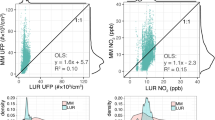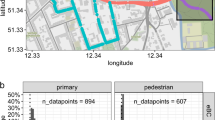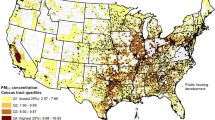Abstract
Residential air exchange rates (AERs) are a key determinant in the infiltration of ambient air pollution indoors. Population-based human exposure models using probabilistic approaches to estimate personal exposure to air pollutants have relied on input distributions from AER measurements. An algorithm for probabilistically estimating AER was developed based on the Lawrence Berkley National Laboratory Infiltration model utilizing housing characteristics and meteorological data with adjustment for window opening behavior. The algorithm was evaluated by comparing modeled and measured AERs in four US cities (Los Angeles, CA; Detroit, MI; Elizabeth, NJ; and Houston, TX) inputting study-specific data. The impact on the modeled AER of using publically available housing data representative of the region for each city was also assessed. Finally, modeled AER based on region-specific inputs was compared with those estimated using literature-based distributions. While modeled AERs were similar in magnitude to the measured AER they were consistently lower for all cities except Houston. AERs estimated using region-specific inputs were lower than those using study-specific inputs due to differences in window opening probabilities. The algorithm produced more spatially and temporally variable AERs compared with literature-based distributions reflecting within- and between-city differences, helping reduce error in estimates of air pollutant exposure.
This is a preview of subscription content, access via your institution
Access options
Subscribe to this journal
Receive 6 print issues and online access
$259.00 per year
only $43.17 per issue
Buy this article
- Purchase on Springer Link
- Instant access to full article PDF
Prices may be subject to local taxes which are calculated during checkout



Similar content being viewed by others
References
Kearney J, Wallace L, MacNeill M, Héroux M-E, Kindzierski W, Wheeler A . Residential infiltration of fine and ultrafine particles in Edmonton. Atmos Environ 2014; 94: 793–805.
Long CM, Sarnat JA . Indoor-outdoor relationships and infiltration behavior of elemental components of outdoor PM2.5 for Boston-area homes. Aerosol Sci Technol 2004; 38: 91–104.
Hänninen O, Hoek G, Mallone S, Chellini E, Katsouyanni K, Gariazzo C et al. Seasonal patterns of outdoor PM infiltration into indoor environments: review and meta-analysis of available studies from different climatological zones in Europe. Air Qual Atmos Health 2011; 4: 221–233.
Breen MS, Schultz BD, Sohn MD, Long T, Langstaff J, Williams R et al. A review of air exchange rate models for air pollution exposure assessments. J Expos Sci Environ Epidemiol 2014; 24: 555–563.
MacNeill M, Wallace L, Kearney J, Allen RW, Van Ryswyk K, Judek S et al. Factors influencing variability in the infiltration of PM2.5 mass and its components. Atmos Environ 2012; 61: 518–532.
Hodas N, Turpin BJ, Lunden MM, Baxter LK, Ozkaynak H, Burke J et al. Refined ambient PM2.5 exposure surrogates and the risk of myocardial infarction. J Expo Sci Environ Epidemiol 2013; 23: 573–580.
Sarnat JA, Sarnat SE, Flanders WD, Chang HH, Mulholland J, Baxter L et al. Spatiotemporally resolved air exchange rate as a modifier of acute air pollution-related morbidity in Atlanta. J Expos Sci Environ Epidemiol 2013; 23: 606–615.
Jones RR, Ozkaynak H, Nayak SG, Garcia V, Hwang S-A, Lin S . Associations between summertime ambient pollutants and respiratory morbidity in New York City: comparison of results using ambient concentrations versus predicted exposures. J Expos Sci Environ Epidemiol 2013; 23: 616–626.
Mannshardt E, Sucic K, Jiao W, Dominici F, Frey HC, Reich B et al. Comparing exposure metrics for the effects of fine particulate matter on emergency hospital admissions. J Expos Sci Environ Epidemiol 2013; 23: 627–636.
Baxter LK, Dionisio KL, Burke J, Ebelt Sarnat S, Sarnat JA, Hodas N et al. Exposure prediction approaches used in air pollution epidemiology studies: key findings and future recommendations. J Expo Sci Environ Epidemiol 2013; 23: 654–659.
Sarnat SE, Sarnat JA, Mulholland J, Isakov V, Ozkaynak H, Chang HH et al. Application of alternative spatiotemporal metrics of ambient air pollution exposure in a time-series epidemiological study in Atlanta. J Expos Sci Environ Epidemiol 2013; 23: 593–605.
Cao Y, Frey HC . Geographic differences in inter-individual variability of human exposure to fine particulate matter. Atmos Environ 2011; 45: 5684–5691.
Burke JM, Zufall MJ, Ozkaynak H . A population exposure model for particulate matter: case study results for PM2.5 in Philadelphia, PA. J Exp Anal Environ Epidemiol 2001; 11: 470–489.
Georgopoulos PG, Wang S-W, Vyas VM, Sun Q, Burke J, Vedantham R et al. A source-to-dose assessment of population exposures to fine PM and ozone in Philadelphia, PA during a summer 1999 episode. J Exp Anal Environ Epidemiol 2005; 15: 439–457.
Isaacs K, Burke J, Smith L, Williams R . Identifying housing and meteorological conditions influencing residential air exchange rates in the DEARS and RIOPA studies: development of distributions for human exposure modeling. J Expo Sci Environ Epidemiol 2013; 23: 248–258.
Chan WR, Nazaroff WW, Price PN, Sohn MD, Gadgil AJ . Analyzing a database of residential air leakage in the United States. Atmos Environ 2005; 39: 3444–3455.
Sherman M, Dickerhoff D . Air-tightness of U.S. Dwellings. Buxton, UK: Lawrence Berkeley Laboratory, 1994 Contract No.: LBL-35700.
Baxter LK, Burke J, Lunden M, Turpin BJ, Rich DQ, Thevenet-Morrison K et al. Influence of human activity patterns, particle composition, and residential air exchange rates on modeled distributions of PM2.5 exposure compared with central-site monitoring data. J Expo Sci Environ Epidemiol 2013; 23: 241–247.
Weisel CP, Zhang J, Turpin BJ, Morandi MT, Colome S, Stock TH et al. Relationship of Indoor, Outdoor and Personal Air (RIOPA) study: study design, methods and quality assurance/control results. J Exp Anal Environ Epidemiol 2005; 15: 123–137.
Williams R, Rea A, Vette A, Croghan C, Whitaker D, Stevens C et al. The design and field implementation of the Detroit Exposure and Aerosol Research Study. J Expos Sci Environ Epidemiol 2008; 19: 643–659.
Breen MS, Breen M, Williams RW, Schultz BD . Predicting residential air exchange rates from questionnaire and meterology: model evaluation in central North Carolina. Environ Sci Technol 2010; 44: 9349–9356.
American Community Survey (2010). Available from http://www.census.gov/acs/www/data_documentation/documentation_main/.
American Housing Survey (2014). US Census Bureau. Available from http://www.census.gov/programs-surveys/ahs/data/2005/2005-ahs-national-puf-microdata.html.
Johnson TA . A Guide to Selected Algorithms, Distributions, and Databases Used in Exposure Models Developed by the Office of Air Quality Planning and Standards. US Environmental Protection Agency, Office of Research and Development: Research Triangle Park, NC. 2002.
Murray DM, Burmaster DE . Residential air exchange rates in the United States: empirical and estimated parametric distributions by season and climatic region. Risk Anal 1995; 15: 459–465.
Johnson T, Long T . Determining the frequency of open windows in residences: a pilot study in Durham, North Carolina during varying temperature conditions. J Exp Anal Environ Epidemiol 2005; 15: 329–349.
Logue JM, Sherman MH, Lunden MM, Klepeis NE, Williams R, Croghan C et al. Development and assessment of a physics-based simulation model to investigate residential PM2.5 infiltration across the US housing stock. Build Environ 2015; 94: 21–32.
Acknowledgements
We would also like to thank Kathie Dionisio of the US EPA’s National Exposure Laboratory for her scientific guidance on this manuscript. The United States Environmental Protection Agency through its Office of Research and Development partially funded and collaborated in the research described here under contract number EPD10070 to Alion Science and Technology Inc. It has been subjected to Agency review and approved for publication.
Author information
Authors and Affiliations
Corresponding author
Ethics declarations
Competing interests
The authors declare no conflict of interest.
Additional information
Supplementary Information accompanies the paper on the Journal of Exposure Science and Environmental Epidemiology website
Supplementary information
Rights and permissions
About this article
Cite this article
Baxter, L., Stallings, C., Smith, L. et al. Probabilistic estimation of residential air exchange rates for population-based human exposure modeling. J Expo Sci Environ Epidemiol 27, 227–234 (2017). https://doi.org/10.1038/jes.2016.49
Received:
Accepted:
Published:
Issue Date:
DOI: https://doi.org/10.1038/jes.2016.49
Keywords
This article is cited by
-
Human exposure factors as potential determinants of the heterogeneity in city-specific associations between PM2.5 and mortality
Journal of Exposure Science & Environmental Epidemiology (2019)
-
The impact of air exchange rate on ambient air pollution exposure and inequalities across all residential parcels in Massachusetts
Journal of Exposure Science & Environmental Epidemiology (2019)
-
Characterizing the impact of projected changes in climate and air quality on human exposures to ozone
Journal of Exposure Science & Environmental Epidemiology (2017)



